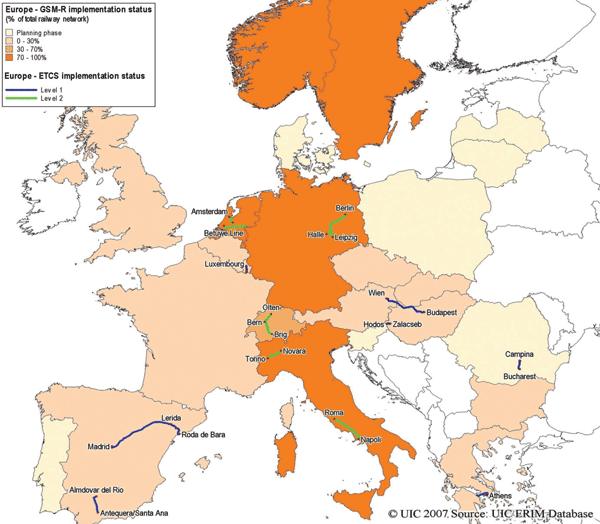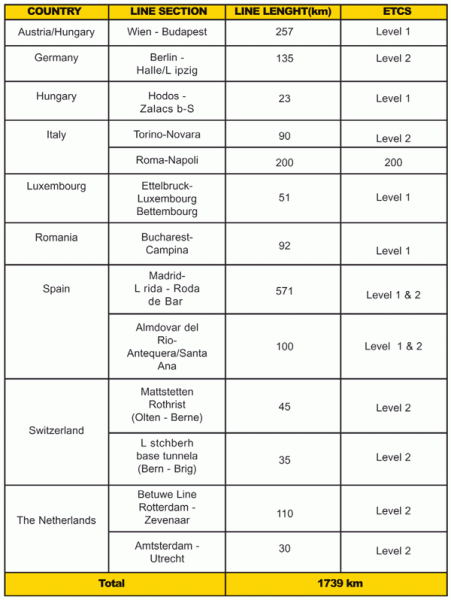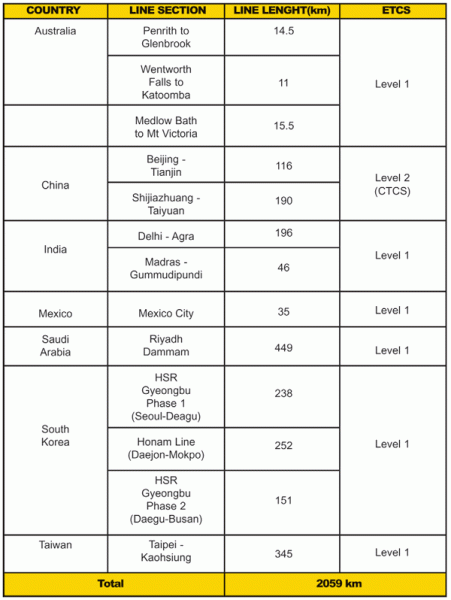ERTMS in 2007
Posted: 28 December 2008 | | No comments yet
ERTMS is the European Rail Traffic Management System – a signalling and train control system promoted by the European Commission for use throughout Europe and specified for compliance with the High Speed and Conventional Interoperability Directives. The system aims to remedy the lack of standardisation in the area of signalling and train control systems which constitutes one of the major obstacles to the development of international rail traffic. Unifying the multiple signalling systems in use will bring increased competitiveness, better inter-working of freight and passenger rail services, stimulate the European rail equipment market, reduce costs and improve the overall quality of rail transport.
ERTMS is the European Rail Traffic Management System – a signalling and train control system promoted by the European Commission for use throughout Europe and specified for compliance with the High Speed and Conventional Interoperability Directives. The system aims to remedy the lack of standardisation in the area of signalling and train control systems which constitutes one of the major obstacles to the development of international rail traffic. Unifying the multiple signalling systems in use will bring increased competitiveness, better inter-working of freight and passenger rail services, stimulate the European rail equipment market, reduce costs and improve the overall quality of rail transport.
ERTMS is the European Rail Traffic Management System – a signalling and train control system promoted by the European Commission for use throughout Europe and specified for compliance with the High Speed and Conventional Interoperability Directives.
The system aims to remedy the lack of standardisation in the area of signalling and train control systems which constitutes one of the major obstacles to the development of international rail traffic. Unifying the multiple signalling systems in use will bring increased competitiveness, better inter-working of freight and passenger rail services, stimulate the European rail equipment market, reduce costs and improve the overall quality of rail transport.
Today, ERTMS is composed of the following two main components:
- GSM-R: a radio digital system used to exchange information between the ground and the train. It is based on the GSM mobile telephony and it is an ETSI Standard. It uses special allocated frequencies and has additional functions, railway needed.
- ETCS (European Train Control System): This is an Automatic Train Protection system, based on cab signalling and spot and/or continuous track to train data transmission. It ensures trains operate safely at all times in providing safe movement authority directly to the driver through the cab display and in continuously monitoring the driver’s actions.
A third component, ETML (European Traffic Management Layer), which relates to traffic management, will be added to GSM-R and ETCS. This component has been demonstrated on the Rotterdam–Milan axis within the ‘Europtirail’ pilot project.
After the necessary phases of studies and system specifications, ERTMS has grown from test tracks to commercial projects. Today, the roll-out of the system has begun on both high-speed and conventional lines with mixed operation; and full revenue service has successfully begun on several lines.
As required by the first Interoperability Directive and the corresponding TSI CCS, all new high-speed lines in Europe have been equipped with ERTMS, as shown in Map 1 on page 66.
Today in Europe, over 1,700km of lines are equipped with ERTMS and in commercial service. Details of the lines are summarised in Table 1. Moreover, there is a medium term objective for a high-speed network in certain railway administrations such as ADIF or RFI.
Regarding rolling stock, more than 800 units are in commercial operation on the ERTMS network with a large amount of retrofitted rolling stock.
The roll-out of ERTMS is not limited to just Europe. Several commercial projects are in progress worldwide like in South Korea, Taiwan and Australia. A snapshot of the worldwide roll-out is presented in Table 2.
In 2007, the GSM-R world changed from that of implementation towards commercial operation. Starting from the implementing stage, where the system is under test, there will be a new status, of a working system, with more then 25% of network in operation, with migrated administrations, where GSM-R remains as the only radio system.
The Netherlands switched off the analogue radio system on 1 January 2007 and four more other administrations will migrate to GSM-R by the end of this year.
Norway has finished deploying its GSM-R network and at the end of 2007, they will migrate to the new system. Sweden has finalised their ‘Step 1’ (8,500km) in 2003, having a mixture of GSM-R / NMT450. They are now in tender for the remaining low density traffic lines (1,500km) and at the end of 2007, they will completely migrate to GSM-R. Germany will have finalised Step 1 in Q4 2007, which means around 24,000km. They are preparing the documents for tendering of Step 2, which means 5,000km more. Step 1 for Italy means 7,500km of Conventional Lines and 1,100km for HSL. Conventional Lines will be ready by the end of 2007.
Meanwhile, certain railway administrations are in the full implementation stage, such as: Austria, Belgium, Greece, Finland, France, Spain, Switzerland and UK. Czech Republic has awarded its first project following the pilot in June and intends to finalise the construction phase by the end of 2009.
Denmark’s radio planning is in progress whilst Bulgaria has awarded a 50km ERTMS pilot, with GSM-R component. Hungary is in the tendering process and Croatia, Lithuania, Poland, Romania and Slovenia are all preparing for tender.
In Europe, 27% of the network planned to be covered with GSM-R is in operation.
ERTMS is on the right tracks thanks to the joint efforts of the railway community and manufacturing industries, and the leadership of the European Community.
Under the impetus of UIC, a new concept for an essential extension of ERTMS to integrate interlocking functionality has been proposed to the European Community to be part of the seven FP related projects, under the name of INESS.
Further development brings the challenge of moving from complex trackside installations to flexible on board trains. On board systems will partly replace track based systems. The amount of trackside equipment will be reduced significantly and this will result in better maintainability, less failures and lower costs in the future.


Map 1


Table 2: Snapshot of the worldwide ERTMS roll-out


Table 2: Snapshot of the world-wide ERTMS roll-out
About the authors
Dan Mandoc
Dan Mandoc graduated from the University in Brasov, Romania and has worked in different positions in the Romanian Railways. During the period between 2002-200, he was Head of the Digital Management Centre for the Romanian Railways Telecom network. Since 2007, he has been working in UIC (International Union of the Railways), as Senior Advisor for GSM-R & Telecom.
Olivier Lévêque
Olivier Lévêque has a PHD in Control of Complex Real Time Systems. Over the course of six years consulting for a major railway industry, he mainly worked on the development of ERTMS starting from technical specifications, design till testing and commissioning on several pilot lines as well as on commercial projects. Further to this experience, he joined an international engineering company dedicated to transport systems in which his activities mainly focused on project management and technical expertise on ERTMS, signalling and system engineering. He joined the UIC as ETCS Senior Advisor at the beginning of 2006.
Issue
Related topics
European Rail Traffic Management System (ERTMS), European Train Control System (ETCS), Global System for Mobile Communications – Railway (GSM-R), Interoperability & Liberalisation








